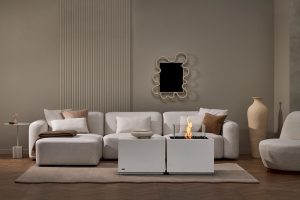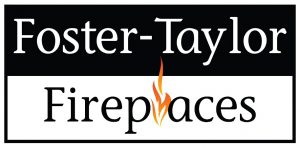Gas log sets offer a convenient alternative to the many hassles of burning wood: procuring, chopping, stacking, hauling, dealing with spiders, bugs, sparks, ashes, creosote, chimney fires, cleaning, and waiting for the embers to die down before going to bed. Gas log sets, whether vented or vent-free, provide instant on and off, no sparks, a ready fuel supply, and an appealing look even when a fire is not burning. While a fireplace should not be viewed as a primary heat source, it can be an excellent supplemental heater, providing warmth to a particular room. Additionally, whether vented or vent-free, it is a great source of emergency heat in the event of a power outage, as gas log sets derive their power from the pilot light and/or batteries.
Vented gas logs, first made in 1958, are much healthier than burning wood because they do not produce wood particulates that can cause irritation. They are designed with a burner that produces a yellow, smoky, wood-like flame and must be used in a fireplace with a working chimney that exhausts all the combustion products. The products of combustion only enter the living space if the chimney does not work properly, so the occupants are unaffected by the by-products of the gas log during normal use. However, most fireplace designs, while efficient in exhausting combustion products, are very inefficient as heaters because much of the heat goes up the chimney rather than into the room. This inefficiency led to the development of vent-free sets.
In 1994, a sixth US manufacturer began making vent-free gas log sets. Since then, various vent-free fireplace products have been created, including many styles of logs and burner arrangements, coal basket fires for smaller Victorian and coal fireplaces, and contemporary gas fires with FireBalls, FireShapes, FireStones, and Fire Glitter. The company has been involved in writing and revising the national standard, ANSI Z1.11.2, to which all vent-free heaters are certified, and is an active member of the Vent-free Gas Products Alliance, an industry group committed to developing and maintaining markets for vent-free heaters.
When deciding between vented pan burner and heat-effect gas log sets, consider the following factors:
Safety: Only safe products are sold, with over 100 years of experience. Proper installation and operation in accordance with the instruction manual and applicable codes and ordinances enhance and ensure safety. All heat-effect gas heaters are equipped with oxygen depletion sensors (ODS) and safety control valves to shut down the unit in case of unhealthful oxygen levels or an interruption in gas supply or flameout. Vented pan burner sets can be ordered with safety control valves for added security.
Efficiency: Heat-effect sets are the best products if you desire a supplemental and/or emergency heat source for the room in which the fireplace is located. With the damper closed, there is no heat loss up the chimney. Note that heat-effect heaters, like all gas-burning appliances, require fresh air for proper combustion. With heat-effect heaters used in the vent-free mode, the products of combustion vent into the living space; with vented pan burner gas logs, the products of combustion vent up the chimney. Some people are more sensitive to the natural odor associated with burning gas, which can be exacerbated by a lack of adequate fresh air.
Important Information about “Partially Vented” or “Reduced Vent” Gas Log Sets: Some manufacturers have introduced gas log sets that allow consumers to close the damper to a minimum opening while enjoying rich, yellow flames and more heat in the room. However, these sets often produce soot, which can either go up the chimney or into the room. The specified “reduced vent” openings are often insufficient to exhaust all combustion products up the chimney, potentially putting soot into the living space. The only true solution for someone who wants to close the damper to less than full open is to use a HEAT EFFECT gas log set that has been certified to ANSI Z21.11.2 Unvented Heater Standard, as these sets are not permitted to produce any soot.
Aesthetics: The flame characteristics of a vented pan burner set are fuller (more BTUs) and more wood-like in appearance. Since the yellow, smoky flame produces carbon (soot), and the standards to which these sets are certified allow more carbon monoxide than heat-effect sets, the damper must be open when operating a vented pan burner set. This results in much of the heat being lost up the chimney. However, ceramic logs and burning embers radiate some heat into the room, and the presence of the flame itself provides a warm feeling.
Soot: Heat-effect gas log sets are not permitted to produce soot by the vent-free standard to which they are certified. This makes them well suited for “smoking” fireplaces that do not draw or vent properly. Vented pan burner gas log sets are designed to burn with a yellow smoky flame that produces soot. These sets require that the chimney flue exhaust all the combustion products up the chimney; otherwise, the soot will enter the living space. This is the trade-off for the rich, luminous flame.
Product Size Selection: Heat-effect gas log sets are available in various sizes with different log appearances and burner styles. Vented pan burner log sets are available in a wide range of sizes, with custom sets available for large and unusual fireplaces. There are many styles of vented pan burner log sets as well as contemporary styles, such as FireBalls, FireShapes, FireStones, and FireGlitter.
Summary: Heat-effect gas log heaters offer the best heat value for your gas dollar spent and provide flexibility of venting, as they can be safely used with no or little damper opening. The vented pan burner set better approximates the aesthetics of a wood fire, with more size, burner style, and control options, as well as the ability to have custom solutions for large and unusual fireplaces. The choice depends on your needs and desires.
Additional information about vent-free sets is important. ANSI Z21.11.2 is the most restrictive of all gas appliance standards, allowing the least amount of carbon monoxide. All vent-free heaters are equipped with an Oxygen Depletion Sensor (ODS), which shuts down the system at oxygen levels below 18%. Vent-free gas log sets are designed to not produce soot and use advanced burners that operate cleanly under adverse conditions.
Initial certification testing is rigorous, and periodic unannounced inspections ensure continued compliance. Vent-free gas log sets, like all gas-burning appliances, require fresh air for proper combustion. Without adequate fresh air, certain odors can become a nuisance, and water vapor, a natural product of combustion, can mix with impurities to cause unpleasant conditions.
For a satisfactory experience with a vent-free heater, ensure adequate fresh air or consider using a vented set with the damper fully open. Vent-free heaters offer flexibility in damper position to balance heat and indoor air quality. The 40,000 BTU/hour maximum gas input restricts the largest width of a vent-free set, and the log stacks are fixed for optimal combustion. Despite these trade-offs, vent-free sets offer efficient heating with virtually no heat loss up the chimney, though they do not look as good as vented sets. Vented sets provide a fuller flame and more flexibility but require the damper to be wide open, resulting in heat loss.
